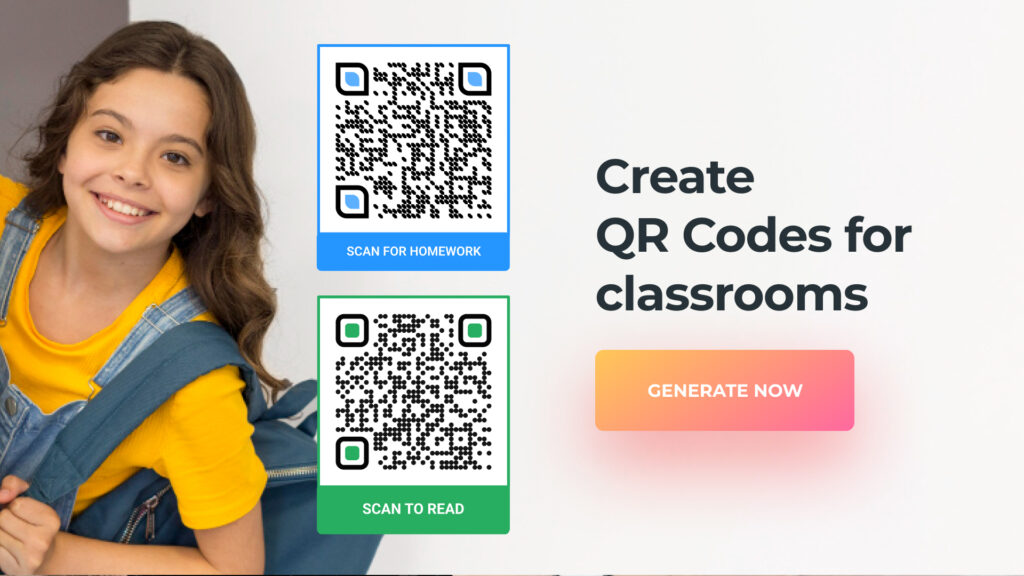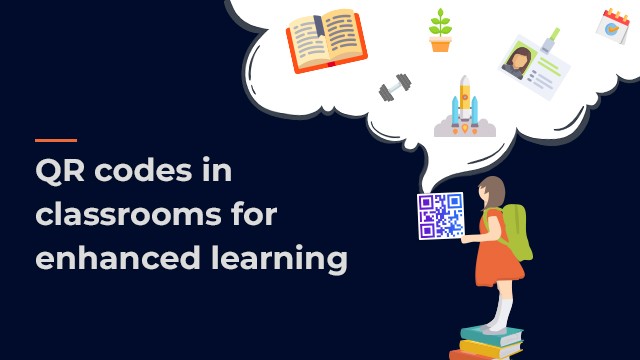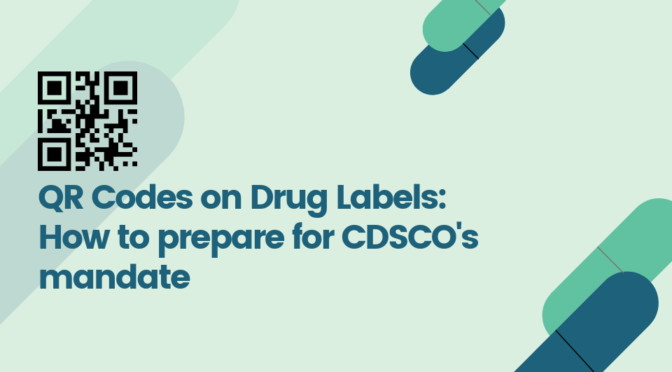With the advent of the 21st century, there was colossal development in various sectors. This development, however, did not leave the education sector untapped.
Learning in this century goes well beyond the four walls of a classroom. A survey in 2016 indicated that daily use of technology in classrooms was up by 55 percent.
When technology is brought in, the attitude of millennial and Gen Z students towards learning can greatly change. Teachers have made a huge observation while switching from traditional textbook reading to technology-based reading.
Interacting with technology is a huge aspect for students of this generation and to be able to use it in a positive manner is an added advantage. One such technological aspect that has taken off in popularity and use cases is QR Codes in the classroom.

Table of Contents
- Importance of QR Codes in education
- Dynamic QR Code generator for educational QR Codes
- 10 valuable use cases of QR Codes in the classroom
- QR Codes for schoolbooks
- QR Codes for unique student identification
- Using QR Codes in the classroom to track attendance
- QR Codes in classrooms for curriculum distribution
- QR Code games for the classroom
- QR Codes in libraries
- QR Codes in co-curricular events
- QR Codes for event announcements and voting
- Specimens and botanical gardens
- Image galleries and digital projects
- Educational QR Codes: Things to keep in mind
- QR Code examples in education: How schools and universities enhance learning
- FAQs for QR Code usage in schools and universities
QR Codes: A quick introduction
QR [Quick Response] Codes are an upgraded version of barcodes that can hold more information and be used in various cases. QR Codes can be scanned by smartphones to reveal the information that they encode. That way, information is shared precisely and with ease with each student. Create a QR Code for your education institute or essay writing service by selecting the best QR Code generator.
According to a survey, a whopping 94% of students want to use their cellphone in classes for educational purposes. With these stats in hand, the fact that students learn better with interactive digital attempts is notable.
RELATED: Comprehensive guide to “What are QR Codes”
Importance of QR Codes in education
Smartphone and internet access in schools with classrooms ranging from kindergarten to 12th grade is a common phenomenon.
With QR Codes, the possibility of use in every grade level and subject has been demonstrated.
You can embed a wide variety of materials in a QR Code. For instance, you can convert an audio file to a QR Code, use a QR Code to display text, create a QR Code for a PDF, turn a URL into a QR Code, and so on.
Ranging from sharing project materials with students, digital slideshows, usage in libraries, and so many versatile uses, QR Codes can function as a great option for interactive education.
Dynamic QR Code generator for educational QR Codes
Let’s say you created a QR Code that links to a teacher evaluation form. After printing the QR Code and distributing it, you find out that the form mentions the wrong classroom.
If you’re using a static QR Code, you’ll need to recreate the QR Code, reprint, and redistribute it – we can agree this isn’t the best experience.
On the other hand, if you’re using a dynamic QR Code generator, you can correct the form and modify the existing QR Code to link to the right destination.
Employing editable QR Codes in the classroom lessens the workload and makes it hassle-free to correct errors.
You can also reuse these QR Codes to link to other websites, forms, videos, and other types of content.
For instance, if you’re conducting a teacher evaluation quarterly or yearly, you can modify the dates on the form and redirect the existing QR Code to the updated form seamlessly.
Also read: Leverage QR Code forms and collect responses easily
Create Educational QR Codes
Make learning innovative and interactive using QR Codes in the classroom!

10 valuable use cases of QR Codes in the classroom
1. QR Code for schoolbooks
You can introduce interactive learning for students by adding QR Codes to study materials. For instance, with a single scan, students can watch videos of science experiments instead of reading about them. You just need to add a video QR Code to your book.
Learn more about QR Codes for books here
2. QR Codes for unique student identification
Manually entering the details of students and uploading the same can be a tedious task. You can eliminate the extra effort by generating a unique QR code for each student, which would encode their personal details, hence making identification easier.
3. Using QR Codes in the classroom to track attendance
You can simplify the process of tracking attendance in the classroom with the help of a QR Code. Students can scan the QR Code to mark their attendance. This eliminates the need for manually calling out each student’s name in the classroom. All in all, QR Code attendance tracking helps teachers manage attendance in an organized manner.
4. QR Codes in classrooms for curriculum distribution
Whenever a teacher assigns a project to students, sharing online resources could be a barrier. Instead, the teacher could upload the links to the resources, encode them in a QR Code and share it among the students.
The teacher can also encourage students to use QR Codes for project submission via text or audio. Distributing answer keys after a unit test can also be made easier using QR codes.
Note: You can easily ensure that your students download the necessary files on their devices for easier reference. Here’s how to create a QR Code to download a file.
5. QR Code games for the classroom
Students can be subjected to fun, engaging activities with QR Codes for scavenger hunts, treasure hunts, learning games and so on. The fact that the interaction starts with them getting out of their seats and moving around has made the implementation a huge success.
6. QR Codes in libraries
Schools can make use of QR codes in libraries to ensure better management. The San Diego State University had QR codes in its library catalog, which, upon scanning, led to information regarding the title, call number, which floor the book was on, and its availability.
You can also use QR Codes to share book reviews and Google Forms that allow students to input their thoughts as well.

7. In co-curricular events and activities
Art classes and other extracurricular activities could make learning much more enjoyable with QR Codes.
If the students have a designated project for a day, it can be embedded within a QR Code and shared with other students.
Digital galleries of the projects can be uploaded and embedded within a QR Code to check on a student’s progress.
8. Event announcements, voting, and additional information
You can use QR Codes on flyers and posters regarding an event, where students can scan and have the event saved on their phones. They can also be used in classroom voting, where the QR Code leads to a Google Form, where they can vote and submit information.
Additional use cases involve QR Codes to help students with homework. In case of a question, they can scan the QR Code to get materials related to the day’s lesson. Using QR Codes to share projects digitally is just scratching the surface when it comes to the scope of QR Code usage.
9. Specimens and botanical gardens
Science-related activities can be more interactive and fun by using QR Codes on specimen bottles and science models. If the school or university has an open area that you can convert into a botanical garden, each plant species can have a small QR Code tag. Upon scanning, it can display species-specific information.

10. Image galleries and digital projects
The school can set up an image gallery QR Code near different sections like the gym and lab to show images of these sections upon scanning.
With most students leaning towards the ease of creating projects using technology, encouraging them to make their projects using QR Codes or cite the resources via QR Codes could be steps towards interactive education.
Educational QR Codes: Things to keep in mind
Select an appropriate QR Code size
Your QR Code should be at least 1 cm x 1 cm in size to be readable by mobile devices.
You can also use this formula to determine the actual minimum size of your QR Code:
QR Code size = Scanning distance/10
The scanning distance is the length between the QR Code and the mobile device.
Check out our ultimate QR Code sizing guide to learn more!
Add a suitable frame CTA
QR Codes can be deployed at all areas of your educational institution. They can link to multiple sources to help students and teachers carry out activities and access the information they need.
One best practice that can help is adding relevant frame text to your QR Code that conveys what it does.
For instance, if you’re sharing a QR Code that shows the curriculum, add a QR Code frame text that says, ‘Scan for school curriculum’ to let users know the content behind the QR Code.
Use a relevant format
To avoid pixelating your QR Codes, we recommend printing them in scalable vector formats such as EPS, SVG, and PDF.
This ensures that your QR Code maintains its resolution after resizing and is easily scannable by mobile devices.
QR Code examples in education: How schools and universities enhance learning
1. University of Texas, Arlington
The library at this university has successfully used this technology in its book reservation and cataloging system. It allows them to easily look up books in the library and make reservations for study rooms and digital resources.
2. University of Manchester, United Kingdom
This university has implemented the usage of QR Codes effectively, such as for events and conference invites, lecture podcast accessibility, attendance count, and even on printed course notes.
Top 10 biometric attendance systems for 2020
3. Duke University, Durham
This university takes the utmost effort to maintain student data privacy and security. This is highlighted in their Multi-Factor Authentication system that requires a QR Code to access it and update information as well.

4. Schools in Kerala to go the digital way
In a first in the state, school textbooks will be embedded with QR codes that, upon scanning, redirect to a mobile application called DIKSHA- which stands for ‘Digital Infrastructure for knowledge sharing’. This allows students to access more information, videos, and notes on topics in the curriculum.

The merit of using this technology lies in the fact that you can apply it to an audience ranging from kindergartens to universities. QR codes have shown a newer, easier way of handling and sharing materials that schools and universities can use, as digital learning is the latest leap in the education world. It not only enhances communication between students and staff but also allows for better management of resources as well.
Also read: Some other innovative ways to make QR Codes for classrooms and engage students
Frequently asked questions for QR Code usage in schools and universities
#1 How are QR Codes used in education?
QR Codes in education are used in a variety of ways:
- Unique student identification
- Attendance tracking
- Curriculum distribution in classrooms
- Engaging games and activities
- Link to book information in libraries
- In co-curricular events
- For event announcements and voting
- For specimens and botanical gardens
- Image galleries and digital projects
#2 How can we use QR Codes in classroom activities?
You can either display the QR Code on a presentation slide or embed it on a worksheet for students to scan and access.
#3 What is the importance of QR Codes in the teaching/learning process?
Since QR Codes are an agile technology, you can use them to link to a plethora of content types, from PDFs to audio and video files. Using QR Codes in the classroom lets teachers use tech-enabled learning to engage students and increase classroom participation. This quickens the learning process and helps students grasp information easier.
#4 How do you create a QR Code for a lesson plan?
- Sign up for Uniqode’s 14-day free trial
- Log in to the dashboard
- If your lesson plan is in a PDF file, select ‘PDF’ from the list of campaign types
- Upload the PDF file or paste the link to it in the space provided
- Customize the QR Code
- Test and download it
Learn more: Use a PDF QR Code generator for your lesson plan
#5 Are there any types of QR Codes?
There are, in fact, two types of QR Codes – Static and Dynamic. Static QR Codes are more preferred for one-time usage, like voting on Google Forms, event advertising, news of the day, and topics that have relevance for a shorter period of time. The information behind static QR Codes, once printed, cannot be changed.
In the case of dynamic QR Codes, you can update the information behind the QR code anytime, without recreating it. For library book updates, dynamic QR Codes can be used.

#6 Aren’t too many QR Codes of the same type confusing to students?
The fact that you can customize QR Codes using various colors and logos is a feature of their success ratio. The school/university logo can also be embedded to make a distinct mark. If a particular QR Code is being used for textbook references, the book’s logo on the QR Code can help students identify it quickly.
Navya is an ardent writer focusing on the benefits of QR Codes for businesses. She has been writing about QR Code topics into action oriented guides since 2019. Presently, she helps people understand the benefits of paid QR Code solutions as a powerful marketing tool. To know more about her work around QR Codes, click here.









